Pro-regime Telegram channels actively condemned both detainees and released unverifiable evidence allegedly from their devices

By Nika Aleksejeva
On May 23, 2021, Belarusian authorities, acting on orders from President Aleksandr Lukashenka, hijacked a Ryanair flight from Athens to Vilnius and detained Roman Protasevich, the former editor-in-chief of the opposition Telegram channel NEXTA, and his girlfriend, Sofia Sapega, a Russian citizen. Soon after, pro-Lukashenka and pro-Kremlin media coverage emerged accusing Protashevich of fighting in the neo-Nazi “Azov” regiment of the National Guard of Ukraine. Sapega, meanwhile, has been accused by pro-government channels of being the curator of the “Black Book of Belarus” Telegram channel, known for doxing law enforcement officers in Belarus.
An analysis by the DFRLab suggested that both of these allegations appeared only after the plane hijacking turned into an international scandal; they also contained numerous inconsistencies. Additionally, on June 3, Belarus state TV channel ONT broadcast an interview with Protasevich, during which he “confessed” for organizing “mass unrest” in Belarus after rigged presidential elections in 2020, praised Belarus authoritarian leader Aleksander Lukashenka, and criticized Belarus opposition. Belarus opposition called it a “hostage” interview, as it happened while Protasevich was in custody. YouTube took down the video, as it was “inappropriate or offensive to some audiences.”
The interview is yet another attempt to build public support to Lukashenka’s extreme actions aimed at eliminating his opposition. The event also possibly inspired Bealrus authorities to “parade” Protasevich at a June 14 press conference during which he made pro-Lukashenka comments; a BBC reporter at the event later described him as “clearly appearing under duress.”
“Editor-in-chief” to “terrorist”
Interest about Protasevich and Sapega spiked in tandem with the plane hijacking, according to Google Trends, a tool that shows how popular a search term was on Google over time. Previously, Google users searched for Protasevich in August and September 2020. In August, the NEXTA Telegram channel, of which Protasevish was editor-in-chief, played a crucial role in reporting on police violence that broke out during the anti-Lukashenka protests organized after Lukashenka declared a contested victory.
On September 28, Protasevich announced he was leaving the NEXTA project. It made some media headlines but did not get significant attention. In fact, media interest in Protasevich did not significantly register until May 23, 2021, the day of his detention. For comparison, prior to May 23, 2021, Protasevich’s name appeared in 48 online media publications in Belarus in Russian; in the days following his detention, he appeared in 224 publications, according to a search conducted using Meltwater Explore. His girlfriend, Sofia Sapega, was not in the public eye at all until she was detained along with him.
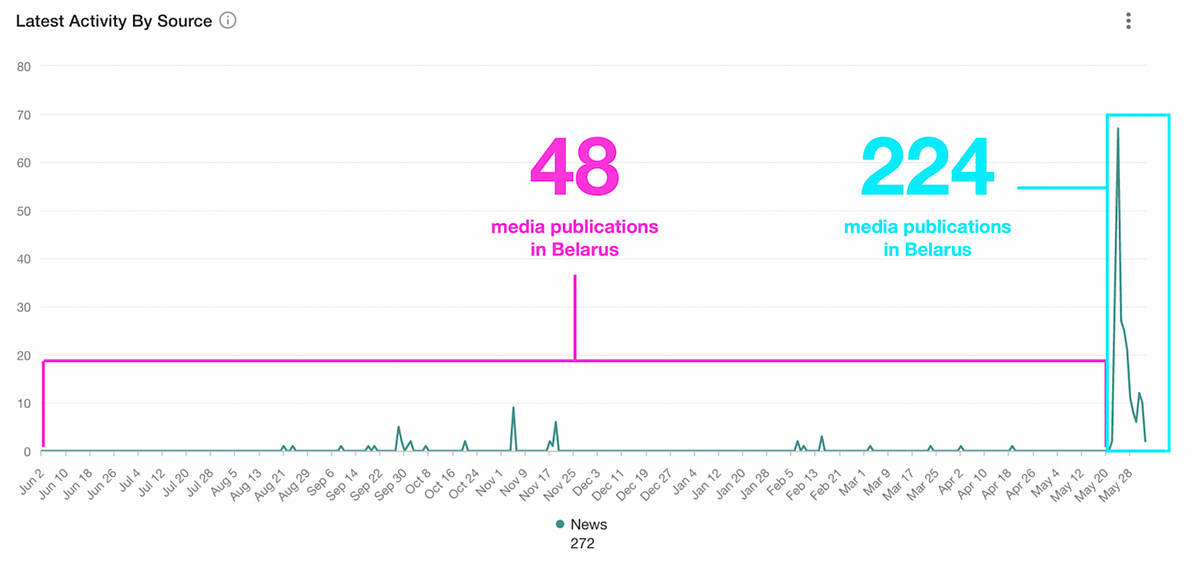
Prior to his detention, Protasevich was mostly referred to in media reports as NEXTA’s editor-in-chief or former editor-in-chief. In November 2020, Protasevich reported on Twitter that the Belarus KGB had included him in the terrorist list. Even after the listing, Sputnik Belarus continued describing Protsaveich as the “former editor in chief of NEXTA.” RIA Novosti, another Kremlin-owned outlet, described the NEXTA Telegram channel as an “opposition” channel, not “extremist.”
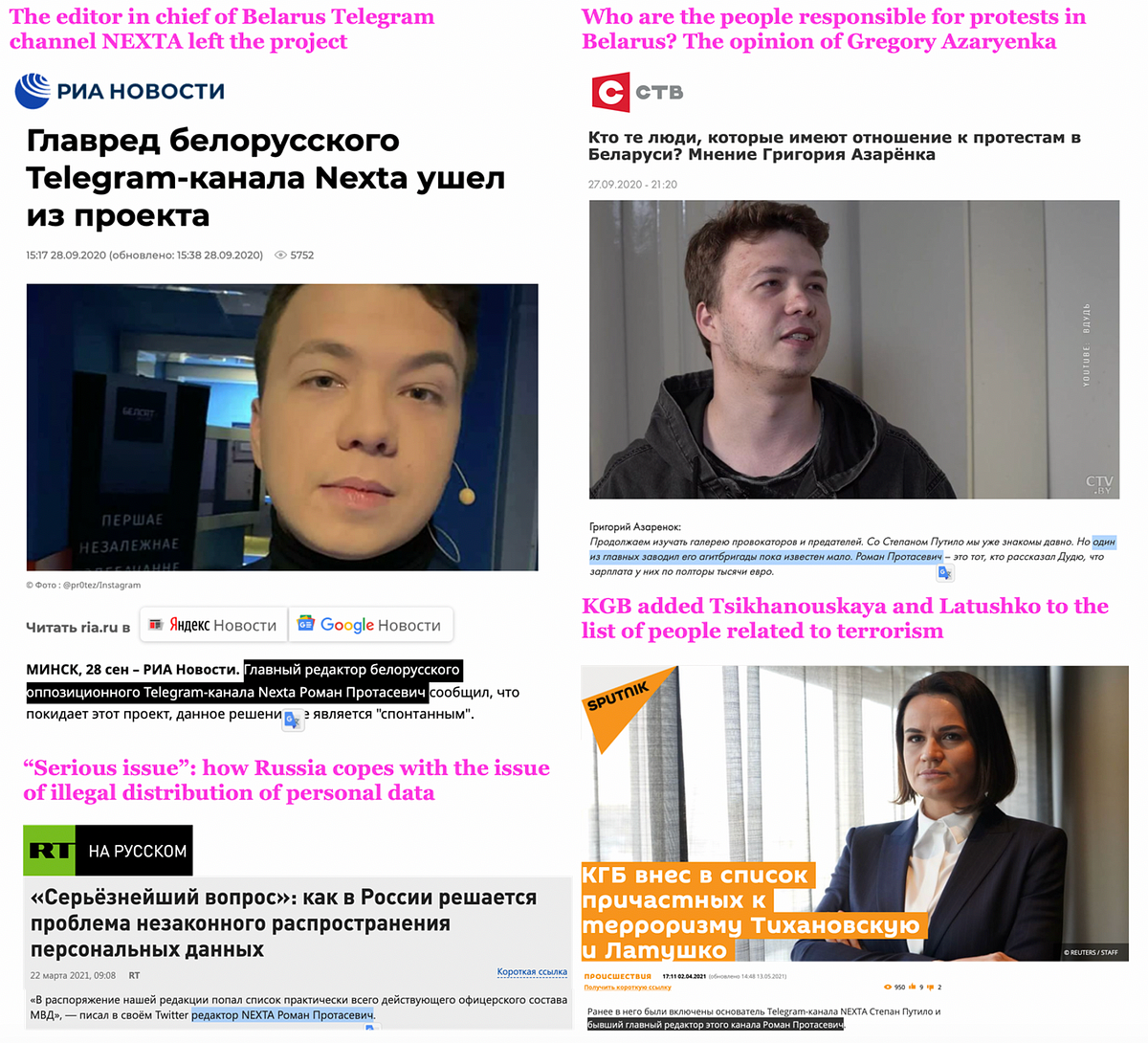
The tone and focus of coverage in Russian and Belarusian state-aligned media changed after Protosevich’s detention. On May 26, Ivan Tartel, the head of the Belarus KGB, emphasized during a meeting with the Belarus government that “there is no doubt that Protasevich meets the definition of a terrorist,” because he allegedly fought against Russia in Eastern Ukraine in 2014 and is responsible for the deaths of civilians. The Belarus KGB made illegal any involvement by Belarus mercenaries in the Russia-Ukraine conflict in 2014.

Soon after, a photo allegedly from Protasevich’s phone appeared on pro-Lukashenka Telegram channels including Zholye Slivy as evidence that he fought in Eastern Ukraine. The photo on the right side shared by Zholye Slivy appeared to be the one used as a featured image of an interview by Radio Svaboda with a Belarusian mercenary nicknamed “Kim,” who was in the Azov regiment.
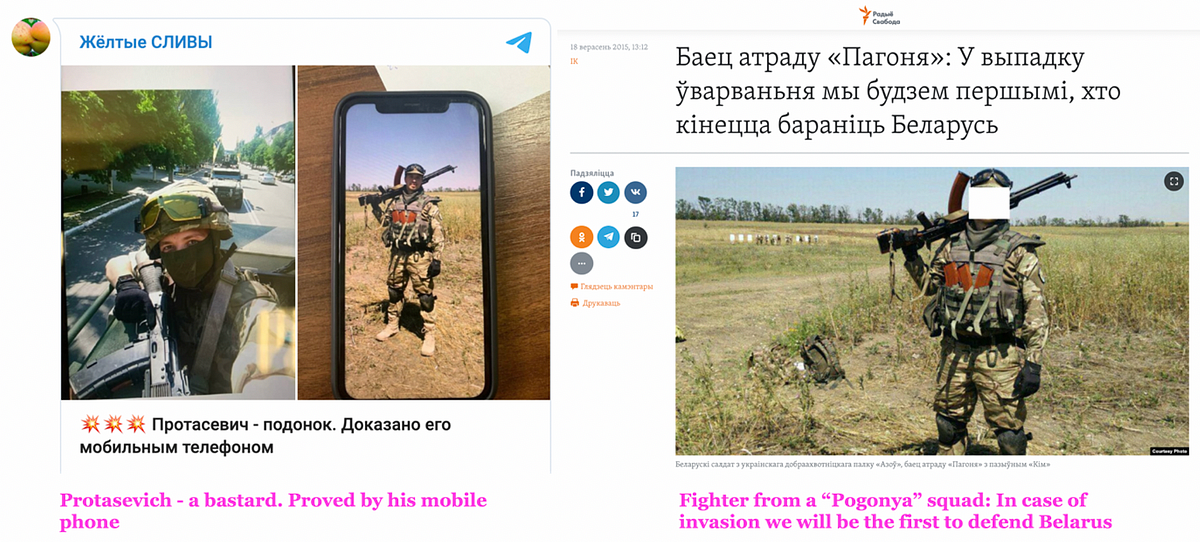
In the interview, Kim mentioned that in 2015, Protasevich was 22 years old. But Protasevich was actually born on May 5, 1995, according to KGB records, meaning he would be 20 years old in 2015. At the same time, Protasevich told a popular Russian blogger, Yury Dudy, in September 2020 that he “spent a year filming in ATO (Anti-Terrorist Operation, a Ukrainian military counter-offensive against pro-Russian forces) as a journalist, freelancer.” Protosevich’s role as a journalist was corroborated by a statement by Andriy Biletsky, the founder of the Azov regiment. In his Telegram channel, Biletsky wrote that Protasevich was embedded alongside the Azov regiment, “but his weapon as a journalist was the word, not a gun.” Protasevich denied to Dudy that he took part in active fighting during his time with ATO, and there is no public evidence proving or denying he did so. A video by Hromadske, an independent Ukrainian media project, shows Protasevich wounded at the ATO, but Protasevich is wearing civilian clothing in the video.
This is not the first time Protasevich has been connected with Azov, although it is the first time these claims have gained significant attention. On September 20, 2020, the Telegram channel Zholye Slivy published Protasevich’s “dossier,” which mentioned his alleged participation in the Azov regiment. Notably, this allegation did not have any legal consequences back in 2015, according to a former Belarus policeman, who worked on the matter.
Nevertheless, the labeling of Protasevich as a pro-Ukrainian Neo-Nazi and alleged war criminal has contributed to the way he is presented to the public now by certain channels. Pro-Kremlin and Belarus media loyal to Lukashenka now refer to him and his Telegram channel primarily as “extremist,” using much more loaded terms than they used prior to his detention.
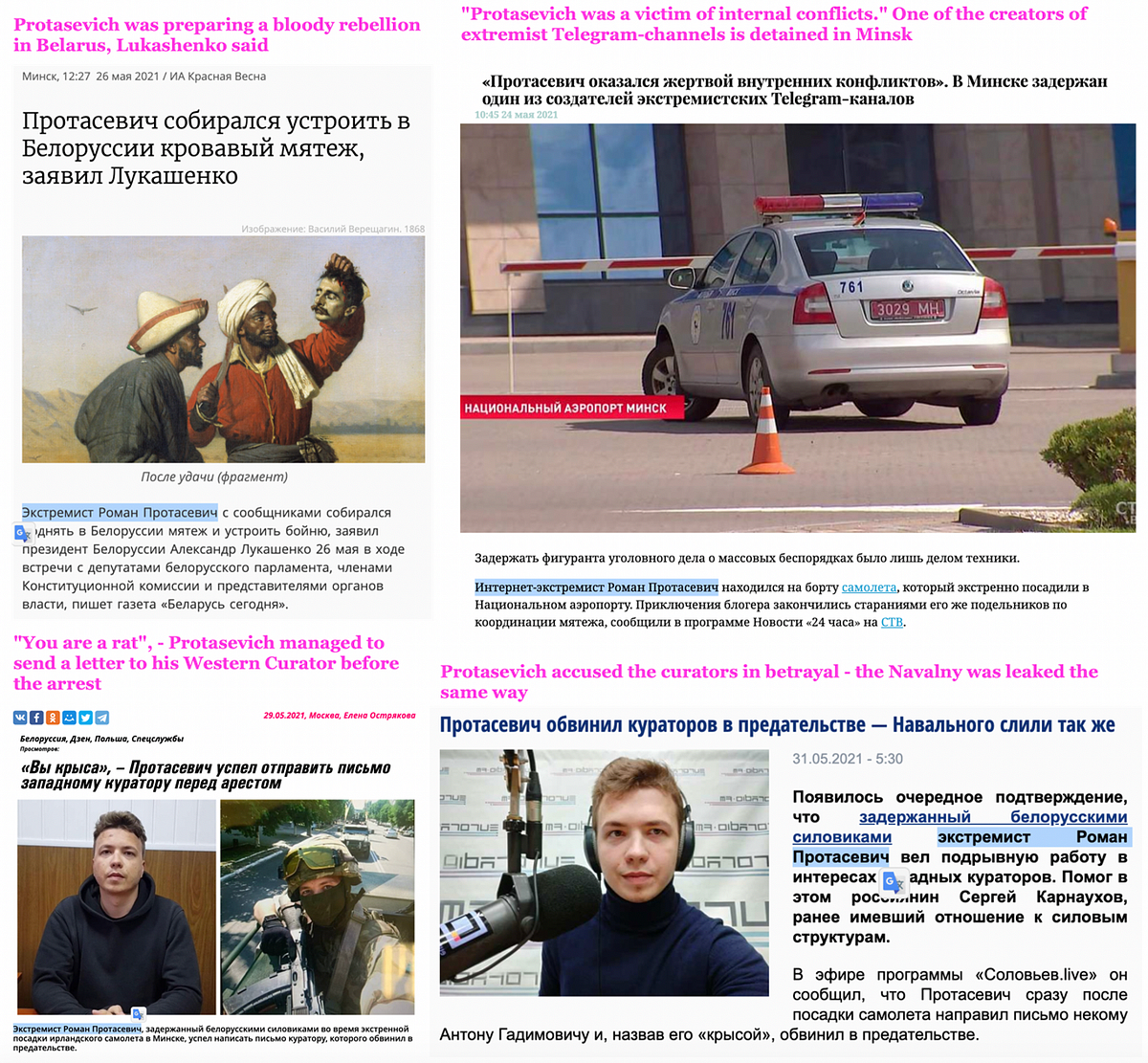
A “bright student” to “cruel doxer”
Protasevich’s girlfriend Sofia Sapega, who was detained alongside Protasevich, was not publicly known prior to his detention. She appeares to have been a student at European Humanities University (EGU) based in Vilnius, Lithuania. Lukashenka ordered EGU to close in 2004, on the grounds that the university taught “European values” to its students.
On May 25, Telegram channel Zholye Slivy released a video “confession” in which Sapega appears to admit that she curated the “Black Book of Belarus” Telegram channel, a channel known for doxing law enforcement officers spotted at violent crackdowns on protesters in Belarus. Sapega’s mother and representatives of the EGU told media that they did not believe the claims.
The Black Book of Belarus Telegram channel remained active after Sapega’s detention. At the time of publishing, the channel was still posting new messages. In October 2020, Belarus police arrested another individual for allegedly publishing personal information to this Telegram channel.
Additionally, on May 26, 2021, Zholye Slivy leaked the supposed cover page of Sapega’s thesis. EGU debunked it as being false due to four reasons: there is no faculty of “International Law” at the university; the title of the thesis was wrong; Sapega is a 5th year student, not a 4th year student; and there is no lecturer named “A.S. Duda” at the university. The fake cover indicated the title of Sapega’s thesis was “The Telegram channel ‘Black Book of Belarus’ as a creation of the ‘New Belarus.’” In fact, however, the real title of Sapega’s thesis, according to a Facebook post by the university, was “Marriage rights: international and regional legislation standards.”
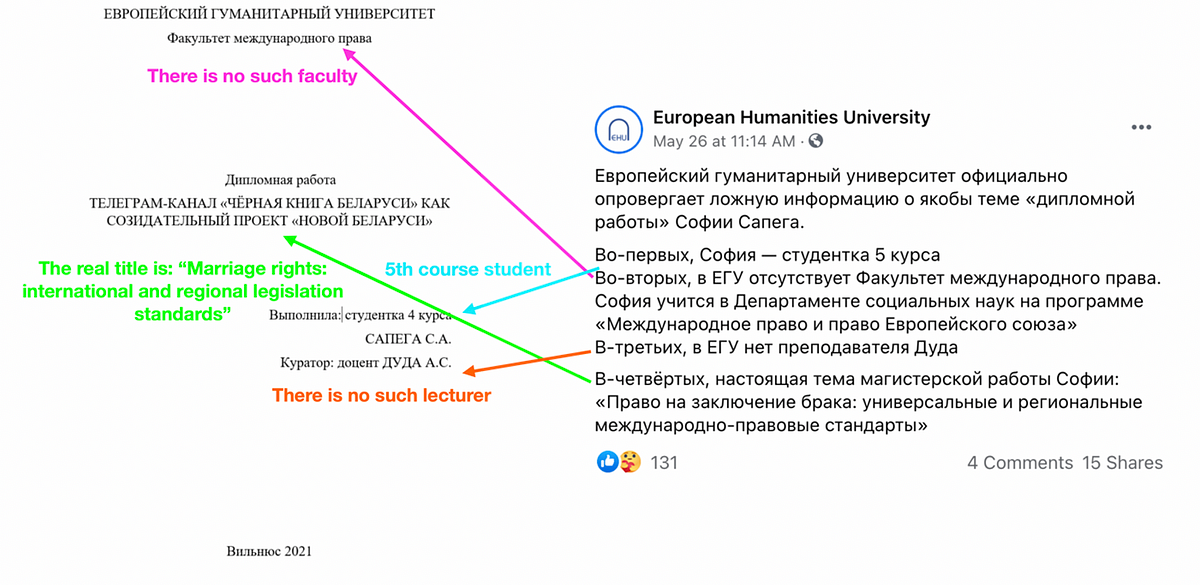
Pro-Lukashenka Telegram channels used the materials published by Zholye Slivy to attack Sapaga. For instance, the Telegram channel BEREZINA wrote, “Could the ‘defenseless girl’ even imagine how many tears, nerves, and insults families and children had to endure while Sapega and others ‘had fun’ while curating the ‘killer Telegram’?” Zheltye Slivy also quoted pro-Russian propagandist Armen Gasparyan, as saying, “Did Sapega have panic attacks? She finally realized what exactly she was doing with her sissy friend Protasevich. They will have to suffer together!” As for Belarusian media, on May 30, pro-Lukashenka TV channel ONT condemned Sapega for curating the Telegram channel and not caring about how relatives of law enforcement officers felt after verbal attacks on them. It was said during a short TV program called “Anti Fake.” The “fake” that was debunked without hard evidence was that “Belarus have problems with freedom of speech.”
The application of the “extremist” and “terrorist” labels to Protasavich and Sapega, despite inconsistent evidence thus far, has allowed pro-Kremlin and pro-Belarus government media and Telegram channels to shift attention to attacks on their character, away from Belarus’s state-sponsored hijacking of a plane to arrest a critic of the regime.
Nika Aleksejeva is a Research Associate, Baltics, with the Digital Forensic Research Lab.
Cite this case study:
Nika Aleksejeva, “Pro-regime Belarus media and Telegram channels reframe political prisoners as extremists,” Digital Forensic Research Lab (DFRLab), June 16, 2021, https://medium.com/dfrlab/pro-regime-belarus-media-and-telegram-channels-reframe-political-prisoners-as-extremists-ee73b9355640.
Follow along for more in-depth analysis from our #DigitalSherlocks.

